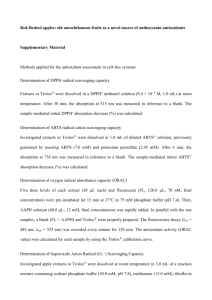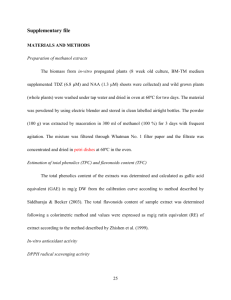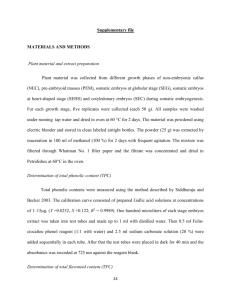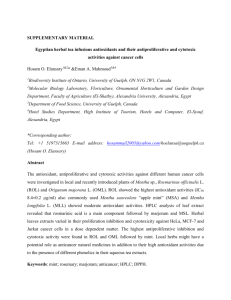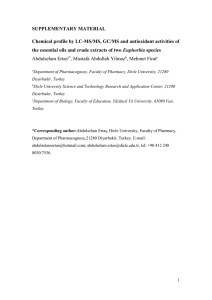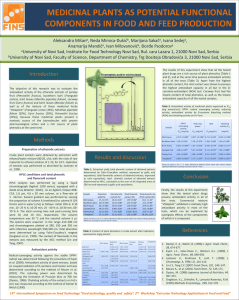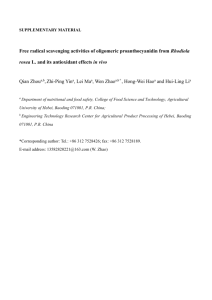Evaluation of antioxidant potentials and ... Indian herbs powder extracts
advertisement
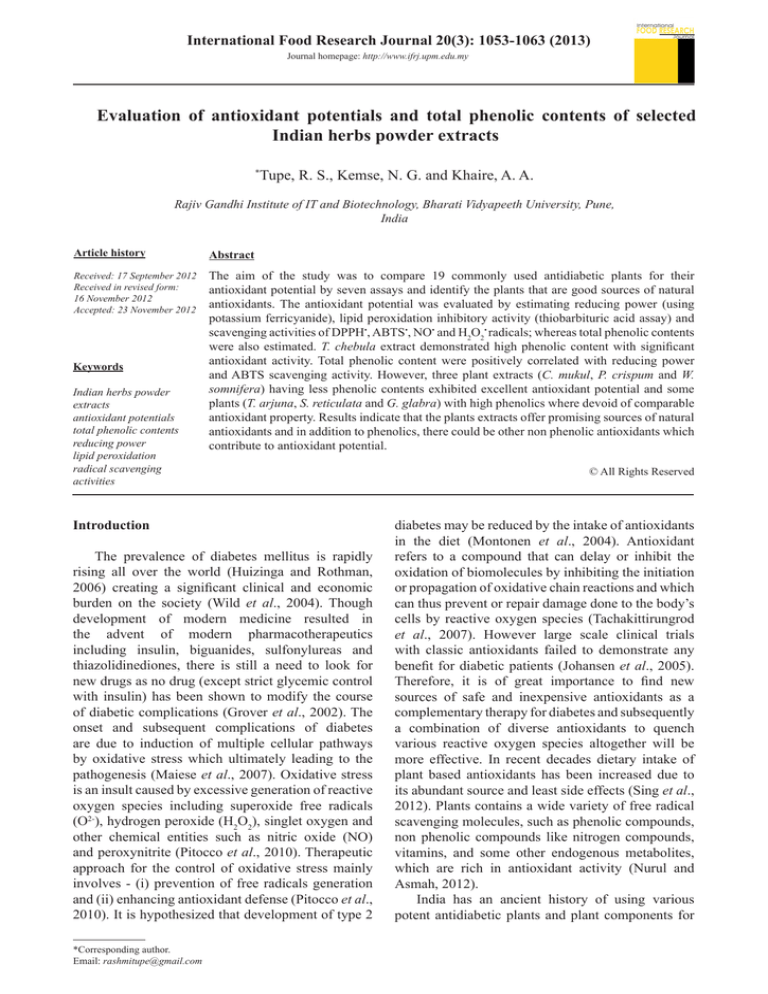
International Food Research Journal 20(3): 1053-1063 (2013) Journal homepage: http://www.ifrj.upm.edu.my Evaluation of antioxidant potentials and total phenolic contents of selected Indian herbs powder extracts Tupe, R. S., Kemse, N. G. and Khaire, A. A. * Rajiv Gandhi Institute of IT and Biotechnology, Bharati Vidyapeeth University, Pune, India Article history Abstract Received: 17 September 2012 Received in revised form: 16 November 2012 Accepted: 23 November 2012 The aim of the study was to compare 19 commonly used antidiabetic plants for their antioxidant potential by seven assays and identify the plants that are good sources of natural antioxidants. The antioxidant potential was evaluated by estimating reducing power (using potassium ferricyanide), lipid peroxidation inhibitory activity (thiobarbituric acid assay) and scavenging activities of DPPH•, ABTS•, NO• and H2O2• radicals; whereas total phenolic contents were also estimated. T. chebula extract demonstrated high phenolic content with significant antioxidant activity. Total phenolic content were positively correlated with reducing power and ABTS scavenging activity. However, three plant extracts (C. mukul, P. crispum and W. somnifera) having less phenolic contents exhibited excellent antioxidant potential and some plants (T. arjuna, S. reticulata and G. glabra) with high phenolics where devoid of comparable antioxidant property. Results indicate that the plants extracts offer promising sources of natural antioxidants and in addition to phenolics, there could be other non phenolic antioxidants which contribute to antioxidant potential. Keywords Indian herbs powder extracts antioxidant potentials total phenolic contents reducing power lipid peroxidation radical scavenging activities Introduction The prevalence of diabetes mellitus is rapidly rising all over the world (Huizinga and Rothman, 2006) creating a significant clinical and economic burden on the society (Wild et al., 2004). Though development of modern medicine resulted in the advent of modern pharmacotherapeutics including insulin, biguanides, sulfonylureas and thiazolidinediones, there is still a need to look for new drugs as no drug (except strict glycemic control with insulin) has been shown to modify the course of diabetic complications (Grover et al., 2002). The onset and subsequent complications of diabetes are due to induction of multiple cellular pathways by oxidative stress which ultimately leading to the pathogenesis (Maiese et al., 2007). Oxidative stress is an insult caused by excessive generation of reactive oxygen species including superoxide free radicals (O2-), hydrogen peroxide (H2O2), singlet oxygen and other chemical entities such as nitric oxide (NO) and peroxynitrite (Pitocco et al., 2010). Therapeutic approach for the control of oxidative stress mainly involves - (i) prevention of free radicals generation and (ii) enhancing antioxidant defense (Pitocco et al., 2010). It is hypothesized that development of type 2 *Corresponding author. Email: rashmitupe@gmail.com © All Rights Reserved diabetes may be reduced by the intake of antioxidants in the diet (Montonen et al., 2004). Antioxidant refers to a compound that can delay or inhibit the oxidation of biomolecules by inhibiting the initiation or propagation of oxidative chain reactions and which can thus prevent or repair damage done to the body’s cells by reactive oxygen species (Tachakittirungrod et al., 2007). However large scale clinical trials with classic antioxidants failed to demonstrate any benefit for diabetic patients (Johansen et al., 2005). Therefore, it is of great importance to find new sources of safe and inexpensive antioxidants as a complementary therapy for diabetes and subsequently a combination of diverse antioxidants to quench various reactive oxygen species altogether will be more effective. In recent decades dietary intake of plant based antioxidants has been increased due to its abundant source and least side effects (Sing et al., 2012). Plants contains a wide variety of free radical scavenging molecules, such as phenolic compounds, non phenolic compounds like nitrogen compounds, vitamins, and some other endogenous metabolites, which are rich in antioxidant activity (Nurul and Asmah, 2012). India has an ancient history of using various potent antidiabetic plants and plant components for 1054 Tupe et al./IFRJ 20(3): 1053-1063 treating diabetes (Grover et al., 2002; Modak et al., 2007). Such plants and their products have been widely prescribed for diabetic management all around the world with less known mechanistic basis of their functioning. Many Indian plants have previously been investigated for their beneficial use in different types of diabetes; however majority of the rich diversity of Indian medicinal plants is yet to be scientifically evaluated for their biological/antioxidant properties. Few plants are well studied for their antioxidant potential in vitro and in vivo with different animal models including human beings; however their complete profiling for antioxidant capacity is still not known. Therefore continuing research is necessary to elucidate the pharmacological activities of plants being used to treat diabetes. In the present study 19 traditionally used antidiabetic medicinal plants have been carefully selected out of which few plants are well studied and many are less explored for their identical comparison through seven in vitro estimations. The selections of 19 plants were based on their traditional usage and also taking into consideration previous studies that have demonstrated their antidiabetic properties (Table 1). The aim of present study was to comparatively investigate the antioxidant potential of these plant extracts through the estimation of total phenolic contents, reducing power, lipid peroxidation inhibitory activity and scavenging activities of DPPH•, ABTS•, NO• and H2O2• radicals. There are no reports about systematic evaluations of these activities for selected antidiabetic plants. This study will determine the plants that are good sources of natural antioxidants, which will be useful for isolating newer antioxidants in future and provide a direct validation of the antidiabetic properties of these ayurvedic plants. Materials and Methods Chemicals 2,2`-diphenyl-1-picrylhydrazyl (DPPH•), 2, 2´azinobis (3 ethyl-benzothizoline 6 sulphonic acid (ABTS•), thiobarbituric acid (TBA), gallic acid, butylated hydroxytoluene were obtained from Sigma Chemical Company (St. Louis, MO, USA). Folin–Ciocalteu reagent, ascorbic acid, methanol, potassium persulfate, Griess reagent A, Griess reagent B, Curcumin, sodium nitroprusside, butylated hydroxytoluene, potassium ferricyanide were purchased from SRL (India). Plant materials and their extraction The botanical names, English names and part used for analysis of 19 dietary plants are listed in Table 1. The powders of specified plant and parts were obtained from the local herbal and Ayurvedic medicine store (Ambadas Vanaushadhalaya, Pune, India) where the authenticated plant parts were collected, dehydrated (in a chamber below 40°C for 48 h), powdered with a mechanical grinder and stored in an air-tight container. The methanolic plant extracts were prepared by adding 1 g of dry powders of selected materials in 100 mL methanol, further stirring at 150 rpm (steelmet incubator shaker, India) at ambient temperature for 3 h. Insoluble residues from the solutions were removed by centrifugation at 8,000 g for 10 min (SuperspinRV/FM, Plasto craft, India) and the clear supernatants were used for analysis. The extracts were stored at 4°C in plastic vials, till further use. All the estimations were performed in triplicates. Estimation of total phenolic content Total phenolic content was determined using the Folin–Ciocalteu reagent (Lim and Quah, 2007). Briefly 300 µL of plant extracts were thoroughly mixed with 1.5 mL of freshly diluted Folin–Ciocalteu reagent (1 N), to which 1.2 mL of sodium carbonate solution (7.5%) was added and the mixture was incubated for 30 min in the dark. The absorbance was measured at 765 nm using Spectrophotometer (UV-10 Spectrophotometer, Thermo Scientific, U. S.). Gallic acid (0.002-0.02 mg/mL) was used as a reference standard. The concentration of phenolic content was expressed as mg of gallic acid equivalents (GAE) per g dry weight. Estimation of reducing power (RP) The RP was estimated by the method of Oyaizu (1986). The mixture containing 2.5 mL of phosphate buffer (0.2 M, pH 6.6) and 2.5 mL of potassium ferricyanide (1% w/v) was added to 1 mL of the plant extract and incubated at 50°C for 20 min. After incubation, 2.5 mL of tricholoroacetic acid (10% w/v) was added and the solutions were centrifuged at 700 g for 10 min. The upper layer (2.5 mL) was collected and mixed with 2.5 mL distilled water and 0.5 mL of FeCl3 (0.1%, w/v). The absorbance was measured at 700 nm against a blank (UV-10 Spectrophotometer, Thermo Scientific, U. S.). Higher absorbance of the reaction mixture indicated increased RP. Lipid peroxidation (LPO) inhibition assay TBA reactive species were used as a measure of the LPO inhibition (Ohkawa et al., 1979). Plant extracts (0.1 mL) was mixed with 0.5 mL egg yolk homogenate (10%) and volume made up to 1mL with distilled water. LPO was induced by adding 0.05 mL of ferrous sulphate (0.07 M) and incubated for 30 min. After incubation, 1.5 mL of acetic acid (20%) and Tupe et al./IFRJ 20(3):1053-1063 Table 1. Scientific name of plants with family, English name, part used for analysis and reported antidiabetic effect Scientific Name Aegle marmelos Family Rutaceae English Name Bael, Bilva Aloe barbadensis Andrographis paniculata Bacopa monnieri Boerhavia diffusa Caesalpinia bonducella Commiphora mukul Glycyrrhiza glabra Gymnema sylvestre Hemidesmus indicus Aloaceae Acanthaceae Part used Reported antidiabetic effect Leaf Streptozotocin-induced diabetic rats (Narendhirakannan and Subramanian, 2010) Aloe vera Latex Type 2 diabetic mice (Tanaka et al., 2006) Indian echinacea Leaf Alloxan-induced diabetic rats (Reyes et al., 2005) Scrophulariaceae Nyctaginaceae Cesalpinaceae Bacopa Leaf Spreading hogweed Leaf Bonducella nut Fruit Diabetic rats (Ghoshet al., 2008) Alloxan induced diabetic rats (Pari and Amarnath, 2004) Alloxan induced diabetic rats (Kannur et al., 2006) Burseracae Fabaceae Asclepiadaceae Asclepiadaceae Salaitree Leaf Licorice, Liquorice Root Gymnema Leaf Indian sarsaparilla Root Ocimum bascilium Ocimum sanctum Ocimum sanctum Petroselinum crispum Salacia reticulata Silybum marianum Swertia chirayita Terminalia arjuna Terminalia chebula Withania somnifera Lamiaceae Lamiaceae Lamiaceae Apiaceae Celastaceae Asteraceae Gentianaceae Combretaceae Combretaceae Solanaceae Common basil Holy basil Holy basil Parsley Salacia Milk thistle Indian gentian Arjuna Myrobalan Winter cherry High fat diet induced diabetic rats (Sharma et al., 2009) Streptozotocin-induced diabetes in rats (Sen and Roy, 2011) Alloxan-induced diabetic rats (Ahmed et al., 2010) Streptozotocin-induced diabetic rats (Gayathri and Kannabiran, 2010) In vitro study (El-Beshbishy and Bahashwan, 2012) Alloxan diabetic albino rats (Kar et al., 2003) Cholesterol fed rabbits (Gupta et al., 2006) Streptozotocin-induced diabetic rats (Ozsoy-Sacan et al., 2006) Diabetic human and rodents (Li et al., 2008) Type II diabetic human patients (Huseini et al., 2006) Streptozotocin-induced diabetic rats (Saxenaet al., 1996) Diabetic human patients (Dwivedi and Aggarwal, 2009) Streptozotocin-induced diabetic rats (Murali et al., 2007) Alloxan diabetic albino rats (Udayakumar et al., 2009) Seed Leaf Seed Leaf Root Seed Leaf Bark Fruit Root 1.5mL of TBA (0.8% w/v in 1.1% sodium dodecyl sulfate) were added, vortexed and the reaction mixture was heated at 95°C for 60 min. After cooling, 5 ml of n-butan-ol was added to each tube and centrifuged at 700 g for 10 min. The absorbance of the upper layer was measured at 532 nm. Inhibition of LPO (%) was calculated as = [(1- A1)/ A0] x 100%. Where, A0 and A1 were the absorbance of the reaction control and with extracts respectively. DPPH• radical scavenging activity The DPPH• radical scavenging activity was estimated by measuring the decrease in the absorbance of methanolic solution of DPPH• (Brand–Willams et al., 1995). In brief, to 5 mL DPPH• solution (3.3 mg of DPPH in 100 mL methanol), 1mL of each plant extracts were added, incubated for 30 min in the dark and the absorbance (A1) was read at 517 nm. The absorbance (A0) of a reaction control (methanol instead of plant extract) was also recorded at the same wavelength. Ascorbic acid (5-50 µg/mL) was used as a standard. Scavenging ability (%) was calculated by using the formula: DPPH• radical scavenging activity (%) = [(A0 − A1)/A0] × 100, where A0 was the absorbance of reaction control and A1 was the absorbance of extracts or standards. ABTS• radical scavenging activity The ABTS• cation radical scavenging activity of the extracts was determined according to the modified method of Re et al. (1999). A stock solution of ABTS was produced by mixing 7 mM aqueous solution of ABTS• with potassium persulfate (2.45 mM) in the dark at ambient temperature for 12–16 h before use. 1055 The radical cation solution was further diluted until the initial absorbance value of 0.7± 0.005 at 734 nm was reached. For assaying test samples, 0.98 mL of ABTS solution was mixed with 0.02 mL of the plant extracts. The decrease in absorbance was recorded at 0 min. and after 6 min. Scavenging ability relative to the reaction control (without plant extract as 100%) was calculated by using the formula: ABTS• radical scavenging activity (%) = [(Initial readingfinal reading)/Initial reading] x 100, where initial reading is absorbance at 0 min. and final reading is absorbance at 6 min. NO• scavenging activity Scavenging activity of NO• radicals was determined as per Garratt (1964). The mixture of 2 mL of sodium nitroprusside (10 mM), 0.5 mL of phosphate buffer saline (pH 7.4) and 0.5 mL of plant extract was incubated at 25°C for 150 min. From this reaction mixture, 0.5 mL taken and 1 mL of Griess reagent A (1% sulfanilamide in 5% phosphoric acid) was added and allowed to stand for 5 min. for diazotization. Subsequently 1mL of Griess reagent B (Napthylethylenediamine dihydrochloride 0.1% w/v) was added in the above mixture and incubated at 25°C for 60 min. The absorbance was recorded at 540 nm. Curcumin (50-500 µg/mL) was used as a reference standard. Scavenging ability (%) was calculated by using the formula- NO• radical Scavenging (%) = [(A0 − A1)/A0] × 100, where A0 was the absorbance of control and A1 was the absorbance in the presence of extracts. H2O2• scavenging activity Scavenging activity of H2O2• was determined as per Ruch et al. (1989). Plant extracts (4 mL) were mixed with 0.6 mL of 4 mM H2O2 solution prepared in phosphate buffer (0.1 M, pH 7.0) and incubated for 10 min at 37 °C. Butylated hydroxytoluene (0.020.08 mg/mL) was used as a reference standard. The absorbance of the solution was taken at 230 nm. Scavenging ability (%) was calculated by using the formulaH2O2• radical scavenging activity (%) = [(A0 − A1)/A0] × 100, where, A0 was the absorbance of control and A1 was the absorbance of extracts or standards. Statistical analysis Pearson correlation matrix was applied to the analytical data to find the relationships between the different analytical methods, which were expressed as the correlation coefficient ‘R’. The associations were Tupe et al./IFRJ 20(3): 1053-1063 determined at first between total phenolic content of the extracts with the antioxidant parameters and then within various antioxidant assays. The significance level (p) of correlation coefficients was related to the critical values for the Pearson product moment correlation coefficient Results Total phenolic content Total phenolic content of the plants was measured using the Folin-Ciocalteu method and the results are presented in Table 2. There was a wide range of phenol concentrations in the medicinal plants as the values varied from 2.34-152.32mg GAE/g. T. arjuna extract showed highest total phenolic content (152.32mg GAE/g) followed by T. chebula (144 mg GAE/g) and S. reticulate (103.42 mg GAE/g). In O. sanctum, results indicated that total phenolic content was four folds higher in leaves (46.43 mg GAE/g) than seeds (10.33 mg GAE/g). Whereas, lowest content of phenolics were observed in A. barbadensis (2.34 mg GAE/g) extract. RP estimation As can be seen from Table 2, the plant extracts had shown reducing activity in terms of Absorbance at 700 nm in the range from 0.13 - 8.01. Thus Fe3+ was transformed to Fe2+ in the presence of plant extracts. Among plants RP of C. mukul was particularly high, indicating that C. mukul extracts has strong capacity of donating electrons, though it has low polyphenols content. Moderately high RP value is shown by T. chebula (4.29) and T. arjuna (4.26), which exhibited very high phenolic levels. While lowest reducing capacity was demonstrated by A. barbadensis which also had least phenolic compounds. Table 2. Total phenolic contents of selected traditional medicinal plants along with their RP and LPO inhibition activity Plants Aegle marmelos Aloe barbadensis Andrographis paniculata Bacopa monnieri Boerhavia diffusa Caesalpinia bonducella Commiphora mukul Glycyrrhiza glabra Gymne ma sylvestre Hemidesmus indicus Ocimum bascilium Ocimum sanctum (lea f) Ocimum sanctum (seed) Petroselinum crispum Salacia reticulata Silybum marianum Swertia chirayita Terminalia arjuna Terminalia chebula Withania somnifera Total Phenolic content (mg GAE */gm sa mple) 63.01 ± 0.21 2.34 ± 0.37 22.39 ± 2.04 RP †(A ‡700nm) 2.67 ± 0.01 0.13 ± 0.01 0.44± 0.01 12.94 ± 1.2 6.36 ± 0.24 37.09 ± 0.37 0.56 ± 0.01 0.48 ± 0.02 1.00 ± 0.01 83.61 ± 1.82 8.01 ± 0.12 71.29 ± 4.67 0.92 ± 0.01 35.92 ± 0.8 1.3 ± 0.03 92.66 ± 3.2 1.12 ± 0.06 15.33 ± 1.82 0.41 ± 0.04 46.43 ± 2.08 1.25 ± 0.03 10.33 ± 0.23 0.35 ± 0.02 25.62 ± 0.15 0.61 ± 0.04 103.42 ± 0.49 18.33 ± 0.16 0.87 ± 0.02 1.87 ± 0.01 38.40 ± 0.41 152.32 ± 2.66 144.00 ± 1.42 0.58 ± 0.03 4.26 ± 0.04 4.29 ± 0.16 6.16 ± 0.63 0.78 ± 0.02 LPO¶ (% inhibition) 46.54 ± 8.02 65.64 ± 10.1 98.34 ± 2.14 96.98 ± 0.52 71.40 ± 4.49 42.53 ± 3.17 84.77 ± 3.69 21.72 ± 12.6 68.79 ± 3.73 95.48 ± 1.20 55.90 ± 9.23 93.17 ± 0.81 56.03 ± 4.96 60.48 ± 9.88 83.86 ± 2.14 61 ± 3.35 62.60 ± 17.1 54.75 ± 6.09 69.68 ± 4.46 72.55 ± 1.83 Va lues a re mea n ± S. D., n=3. * GAE= Ga llic Acid Equiva lent † RP= Reducing Potentia l ‡ A= Absorba nce ¶ LPO= Lipid peroxida tion 9 8 7 Reducing power (A 700 nm) 1056 6 R value= 0.63 5 4 3 2 1 0 LPO inhibition activity Table 2 shows anti-LPO activities of extracts which ranged from 21.72 to 98.34 %. High LPO inhibitiory activity was found in A. paniculata extract (98.34%) followed by B. monnieri (96.98%), H. indicus (95.48%) and O. sanctum- leaf (93.18%), whereas lowest inhibition was noted in G. glabra extract (21.72%). In O. sanctum distinct variation in LPO inhibition was seen in the different parts as leaves extract showed higher inhibition (93.18%) than seeds extracts (56.03%). DPPH• radical scavenging ability Table 3 illustrates a variation in DPPH• scavenging activity of the plants which ranged from 26.26 to 96.01%. In several plants potent (> 90%) activity was 0 20 40 60 80 100 120 140 160 Total phenolic content (mg GAE/ gm sample) Figure 1. Correlation between the total polyphenols and the RP value of plants noted indicating they have effective hydrogen donors or electron acceptor thus scavenging the free DPPH• radical. C. bonducella exhibited the highest (96.01%) activity, closely pursued by W. somnifera (95.31%) and A. marmelos (95.18 %). These plants had low phenolic content, whereas those plants with high quantity of phenolics like T. arjuna, S. reticulata, H. indicus showed comparatively weaker scavenging activity (< 90%) except T. Chebula which had equally robust properties. Lowest scavenging activity was Tupe et al./IFRJ 20(3):1053-1063 Table 3. Scavenging activities of plants for DPPH, ABTS, NO and H2O2 radicals Plants Aegle marmelos Aloe barbadensis Andrographis paniculata Bacopa monnieri Boerhavia diffusa Caesalpinia bonducella Commiphora mukul Glycyrrhiza glabra Gymne ma sylvestre Hemidesmus indicus Ocimum bascilium Ocimum sanctum (lea f) Ocimum sanctum (seed) Petroselinum crispum Salacia reticulata Silybum marianum Swertia chirayita Terminalia arjuna Terminalia chebula Withania somnifera DPPH* (% sca venging a ctivity) 95.18 ± 3.33 ABTS† (% sca venging a ctivity) 98.91 ± 0.46 NO ‡ (% sca venging a ctivity) 32.80 ± 1.73 H2 O2¶ (% sca venging a ctivity) 16.52 ± 3.3 26.26 ± 4.92 8.33 ± 1.08 ND § 10 ± 2.26 58.41 ± 1.39 57.27 ± 4.88 ND § 33.22 ± 4.02 89.14 ± 0.43 29.41 ± 0.41 30.63 ± 8.54 17.73 ± 3.29 40.67 ± 1.07 23.08 ± 0.79 13.52 ± 2.2 26.86 ± 0.58 96.01 ± 0.34 72.66 ± 12.3 20.12 ± 2.27 25.40 ± 3.59 92.06 ± 0.28 97.07 ± 0.46 32.90 ± 1.15 33.22 ± 27.2 87.64 ± 0.7 87.86 ± 2.99 51.44 ± 0.22 14.51 ± 4.86 91.78 ± 0.4 96.78 ± 0.5 31.02 ± 1.9 5.32 ± 3.47 87.62 ± 0.18 99.43 ± 0.14 16.78 ± 2.94 17.52 ± 2.32 93.93 ± 0.39 20.61 ± 1.72 29.35 ± 2.85 9.50 ± 3.89 84.47 ± 0.89 95.85 ± 0.38 25.05 ± 0.43 15.33 ± 2.89 78.45 ± 2.73 33.75 ± 3.69 5.073 ± 2.25 8.87 ± 5.14 93.33 ± 0.84 74.40 ± 2.84 25.68 ± 0.65 60.27 ± 16.8 84.27 ± 0.54 99.95 ± 0.08 25.15 ± 0.54 4.35 ± 2.84 92.45 ± 1.91 53.44 ± 0.71 34.69 ± 1.19 20.75 ± 1.08 87.58 ± 0.37 71.67 ± 1.72 25.05 ± 0.48 45.51 ± 1.24 79.01 ± 0.12 98.91 ± 0.33 33.61 ± 0.82 ND § 92.42 ± 0.96 100 ± 0.21 34.66 ± 2.31 27.70 ± 15.2 95.31 ± 0.7 29.83 ± 5.2 13.20 ± 0.83 84.49 ± 7.72 H2O2• scavenging activity The ability of extracts to scavenge H2O2• is shown in Table 3 where a wide variation in scavenging activity was observed from negligible to 84.49%. W. somnifera exhibited maximum scavenging activity (84.49 %), followed by P. crispum (60.27%). Surprisingly, higher H2O2• scavenging activity was noticed in W. somnifera, P. crispum, S. chirayita extracts, which have very less phenols contents, while in plants with high phenolic levels such as T. chebula and S. reticulata, less scavenging activity was exhibited. It is interesting to note the totally absent H2O2• scavenging activity in T. arjuna extract which exhibited highest phenolic content. ABTS scavenging activity (%) R value = 0.76 120 100 80 60 40 20 0 0 50 100 150 lowest activity (8.33 %). NO• scavenging activity The analyzed plant extracts showed the scavenging of NO• radicals in the range from negligible to 51.44% (Table 3). Maximum activity was found in the extracts of G. glabra (51.44%) and many plant extracts showed scavenging from 30.6 to 34.6%. A. barbadensis and A. paniculata extracts were totally devoid of this activity. Va lues a re mea n ± S. D., n=3. * DPPH= 2,2’-diphenyl-1-picrylhydra zyl † ABTS= 2,2'-a zinobis-(3-ethylbenzothia zoline-6-sulfonic a cid) ‡ NO= Nitric oxide ¶ H 2 O2 = Hydrogen peroxide § ND=Not detecta ble. 140 1057 200 Total phenolic content (mg GAE/gm sample) Figure 2. Correlation between total polyphenols and ABTS scavenging activity of plants demonstrated by A. barbadensis which had least phenolic compounds. ABTS• radical scavenging ability As presented in Table 3, ABTS• radical scavenging ability, ranged from 8.33 to 100%. T. chebula extract showed the highest scavenging capacity (100%) followed by S. reticulate (99.95 %), H. indicus (99.43%), A. marmelos (98.91%) and T. arjun (98.91%), whereas A. barbadensis exhibited Correlation between antioxidant characteristics A correlation analysis was used to determine the relationship between various assay parameters. The correlation coefficients of total phenolic content with other parameters were as follows: total phenolic content vs. RP (R = 0.63, p<0.001, Fig. 1); total phenolic content vs. LPO (R = -0.02, not significant); total phenolic content vs. DPPH• free scavenging activity (R = 0.28, not significant); total phenolic content vs. ABTS• scavenging activity (R = 0.78, p<0.001, Fig. 2); total phenolic content vs. NO• scavenging activity (R= 0.48, p<0.05); total phenolic content vs. H2O2• scavenging activity (R value = -0.3, not significant). Additionally within antioxidant assays, it was found that ABTS• scavenging activity was marginally correlated with RP (R= 0.52, p<0.05) and DPPH• free scavenging activity (R = 0.5, p<0.01) whereas between DPPH• scavenging activity and LPO inhibition negative correlation (R= - 0.16, not significant) was noticed. Discussion The antioxidant potential of the plant extracts are influenced by various factors and largely depends on both the composition of the extract and the analytical test system. Thus, it is necessary to perform more than one type of antioxidant capacity measurements 1058 Tupe et al./IFRJ 20(3): 1053-1063 to take into account the various mechanisms of antioxidant action (Frankel and Meyer, 2000) which will give more reliable results. Hence the assessment of antioxidant capacities of 19 selected antidiabetic medicinal plants were done by seven assays which are based on different approaches through estimation of i) total phenolic content, ii) RP, iii) LPO and scavenging ability of- iv) DPPH•, v) ABTS•, vi) NO• and vii) H2O2• radicals. The systematic evaluation of antioxidant content of the many currently used plants is not yet available, which is desirable to validate traditional knowledge based on scientific evidence. The results indicated that the same plants extracts had different antioxidant capacities in relation to the various method applied. Highest phenolic content was observed in T. arjuna which contains ‘arjunolic acid’ a triterpenoid saponin which is a potent antioxidant, free radical scavenger and reported to have a protective role against type I, type II diabetes even in diabetic renal dysfunctions (Hemalatha et al., 2010). From T. chebula extracts, Manosroi et al. (2010) have identified six phenolic compounds as gallic acid, punicalagin, isoterchebulin, 1,3,6-tri-O-galloyl-β-D-glucopyranose, chebulagic acid and chebulinic acid which have antioxidant activities of different magnitudes of potency (Manosroi et al., 2010). Hazra et al. (2010) reported the total phenolic content from T. chebula was about 127.60 mg GAE/100 mg extract, which is found to be 144 mg GAE/1 g in the current study. In O. sanctum, higher phenolic content in leaves than seeds in this study was comparable to that reported by Hakkim et al. (2006), even though our values were higher than their data. Our results of A. barbadensis where lowest phenolic content was found are in accordance with the literature as Zheng et al. (2003) also observed lowest phenolic concentration (0.23 mg of GAE/g of fresh weight) among the various 39 plants used for their study. However its polyphenol-rich extract was reported to be effective for the control of insulin resistance in mice (Pérez et al., 2007). The slight disparities in values may be attributed to their geoclimatic conditions, state of maturity and method of sample preparation. Polyphenols possess ideal structural chemistry for free radical-scavenging activities which have shown to be more effective antioxidants in vitro than vitamins E and C on a molar basis (Rice-Evans et al., 1997). The chemical activities of polyphenols in terms of their reducing properties as hydrogen or electron-donating agents predict their potential for action as free-radical scavengers (antioxidants). The activity of an antioxidant is determined by: (i) Its reactivity as a hydrogen or electron-donating agent (which relates to its reduction potential i.e. RP), (ii) The fate of the resulting antioxidant-derived radical, which is governed by its ability to stabilize and delocalize the unpaired electron, (iii) Its reactivity with other antioxidants and (iv) The transition metalchelating potential. In RP assay, Fe (III) reduction is often used as an indicator of electron donating activity, which is an important mechanism of phenolic antioxidant action (Nabavi et al., 2009) as the presence of antioxidants in the samples would result in the reducing Fe3+ to Fe2+ by donating an electron. Amount of Fe2+ complex can then be monitored by measuring the formation of Perl’s Prussian blue at 700 nm. Higher absorbance at 700 nm indicates greater reductive ability (Chung et al., 2002). Among plants, maximum RP value was observed in C. mukul which is reported to contain various steroids including the two isomers E- and Z-guggulsterone (cis- and trans-4, 17(20)pregnadiene-3, 16-dione) (Deng, 2007). The RP exhibited by T. chebula (at 1.0 g/ mL) was 4.26 much lower than reported values as 0.25 at 1.0 mg/ mL (Hazra et al., 2010). For LPO assay, egg yolk lipids undergo nonenzymatic peroxidation upon incubation in the presence of FeSO4, resulting in formation of malondialdehyde that form pink chromogen with TBA, absorbing at 532 nm (Kosugi et al., 1987). In this assay, iron induces LPO through Fenton reaction (H2O2 + Fe2+ = Fe3+ + OH- + OH.) which leads to the formation of lipid hydroperoxides. Oxidative and reductive decomposition of hydroperoxides into peroxyl and alkoxyl radicals that can perpetuate the chain reaction further amplifies the peroxidation process (Halliwell, 1991). The presence of chainbreaking phenolic antioxidants provides a means of intercepting this peroxidation process (Rice-Evans et al., 1997). Maximum LPO inhibition was displayed by A. paniculata though it contained fewer amounts of phenolic compounds (22.39 mg GAE/g), which is in consensus with the similar reported value of about 80% LPO inhibition (Pérez et al., 2007). This plant contains two bioactive compounds, andrographolide and 14-deoxy-11, 12-didehydroandrographolide demonstrated to exhibit LPO inhibition and free radical scavenging activities by Akowuah et al. (2006). The negative correlation between LPO and total phenolic content may be explained by the fact that although hydrogen abstraction is the most important mechanism other factors e.g., oil–water partition behavior, electron-transfer process, stability of phenoxyl radicals and absolute chemical hardness also regulate the anti-LPO potentials of phenols to a significant degree (Cheng et al., 2003). The current Tupe et al./IFRJ 20(3):1053-1063 results also suggest the presence of non-phenolic components in extracts, which may be inhibiting the LPO reactions predominantly. DPPH• is relatively stable nitrogen centered free radical and gives absorbance at 515 nm (visible deep purple color) that decolorizes easily by accepting an electron or hydrogen radical donated by an antioxidant compound to become a stable diamagnetic molecule. This assay is a sensitive way to survey the antioxidant activity (Singh et al., 2012) which is strongly dependent on solvent type, pH and temperature of the system (Settharaksa et al., 2012). Maximum DPPH• scavenging activity was noticed in C. bonducella which was analogous to the reported study by Shukla et al. (2010). In O. sanctum, higher DPPH• scavenging activity in leaves than seeds in this study was in coherence with previous study by Hakkim et al. (2006), where they reported IC50 value 0.46 mg/mL for leaves extracts and 0.83 mg/mL for extracts of inflorescence. The ABTS• radical scavenging assay is one of the popular indirect methods of determining the antioxidative capacity of compounds (Roginsky and Lissi, 2005). ABTS• is a blue chromophore produced by the reaction between ABTS and potassium persulfate. In the absence of antioxidants, the ABTS• radical is rather stable, but it reacts energetically with a hydrogen atom donor and is converted into a noncolored form of ABTS• and thus addition of the plant extracts to the pre-formed radical cation reduced it. The highest ABTS• radical scavenging activity of T. chebula indicated that all ABTS• radicals in the assay system were scavenged by the plant extract; this is supported by parallel investigation by Manosroi et al. (2010). From literature survey on S. reticulata, it appears that present study for the first time reporting its in vitro antioxidant activity values, although many researchers summarily proved its antioxidant potential in rodent models (Vasi and Austin, 2009). It is well known that NO• has an important role in various inflammatory processes. Sustained levels of NO• production are directly toxic to tissues and contribute to the vascular collapse associated with septic shock, whereas chronic expression of NO• radical is associated with inflammatory conditions including juvenile diabetes (Taylor et al., 1997). The toxicity of NO• increases greatly when it reacts with superoxide radical, forming the highly reactive peroxynitrite anion (ONOO-) (Miller et al., 1993). The NO• generated from sodium nitroprusside reacts with oxygen to form nitrite and the antioxidant inhibits nitrite formation by directly competing with oxygen. For the tested plants extracts, almost the same order for NO• scavenging activity was reported 1059 by Jagetia and Baliga (2004). G. gabra root extract which is known to contain number of biologically active components such as glycyrrhizin, flavonoids, glycyrrhetic acid (Obolentseva et al., 1999) and recently it is discovered that in THP-1 cells, it inhibits the NO• synthase activity therefore improve antioxidant condition and thus prevents inflammation (Franceschelli et al., 2011). The NO scavenging activity exhibited by T. chebula (at 1.0 g/ mL) was 34% much lower than reported values as 59% at 1.0 mg/ mL (Hazra et al. 2010). In vivo by many oxidizing enzymes such as superoxide dismutase H2O2• is formed, which crosses membranes and oxidizes a number of compounds. It inactivates a few enzymes directly by oxidation of essential thiol (-SH) groups. Intracellularly it also reacts with Fe2+ and possibly Cu2+ ions to form hydroxyl radicals which further amplify its toxic effects (Valko et al., 2007). The scavenging activity exhibited by O. sanctum plant part extracts (at 1.0 g/ mL) on H2O2• was 15% (leaves) and 8.8% (seed) was much lower than reported values as 68% (leaves) 48% (inflorescence) at 1.0 mg/ mL (Hakkim et al., 2006). Scavenging of H2O2• by extracts may be attributed to their phenolics, which can donate electrons to H2O2•, thus neutralizing it to water (Ebrahimzadeh et al., 2010). However, Yoshiki et al., (2001) illustrated that H2O2• scavenging activity corresponded with H2O2/ polyphenol levels rather than with only polyphenol levels. This may explain our observed results as no association was found between phenolic contents and H2O2• scavenging activity of plants. The strong correlations between the results of RP, ABTS• scavenging activity and the total phenolic content suggests that phenolic compounds largely contribute to the antioxidant activities of these plants and therefore could play an important role in the beneficial effects of these plants. Though both ABTS• and DPPH• radicals indicate the hydrogen atom donating capacity of extracts, however the reaction kinetics between phenols and ABTS• radical have been different from that between phenols and DPPH• radical over a similar range of sample concentrations, as reactions of phenols with ABTS• radical cation are usually rapid, but the reactions with DPPH• radical differ from compound to compound (Apak et al., 2007). Moreover the high-pigmented and hydrophilic antioxidants are better reflected by ABTS• assay than DPPH• assay (Floegel et al., 2011). The observed negative association between DPPH• scavenging activity and LPO inhibition is supported by Apak et al. (2007) as many antioxidants that react quickly with peroxyl radicals may react slowly or may even be inert to DPPH•. Since 1060 Tupe et al./IFRJ 20(3): 1053-1063 DPPH• is long-lived nitrogen radical, which bears no similarity to the highly reactive and transient peroxyl radicals involved in LPO, indicating extracts different mode of action in LPO inhibition and DPPH radical scavenging. The observed discrepancy in the phenolics-antioxidant association in some plants like T. arjuna, S. reticulata and G. glabra, C. mukul, P. crispum and W. somnifera meets the general agreement that the extracts of medicinal plants often contain complex mixtures of different kinds of active compounds and the contribution from compounds other than phenolics should not be neglected. Conclusion In this study, antioxidant potential and total phenolic contents of 19 selected medicinal plants were evaluated. In summary, our results support the view that (a) antidiabetic plants are promising sources of natural antioxidants, (b) antioxidant potential varies considerably among different assays, hence it is imperative to resort to multiple antioxidant measurements for appropriate interpretation, (c) significant correlation exists between total phenolic compounds and RP as well as ABTS• scavenging activity, (d) strongest antioxidant potential was observed in T. chebula since it exhibited abundant phenolic content, outstanding reducing power and highest radical scavenging activities. However few plants with less total phenolic content showed good antioxidant potential like C. mukul, P. crispum and W. somnifera while some plants such as T. arjuna, S. reticulata and G. glabra which exhibited relatively high phenolic content, but devoid of comparable antioxidant potential. It is therefore reasonable to conclude that in addition to phenolics, there could be other bioactive compounds present in plants which contribute to antioxidant potential. These results also provide a biochemical rationale which can be very useful for further planning of clinical nutrition and epidemiological diabetic research studies on bioactive compounds of plants and development of antidiabetic dietary products. Acknowledgements The research study was funded and supported by Bharati Vidyapeeth Deemed University, Pune. We thank late Professor R. M. Kothari for his helpful suggestions and critical comments. The authors are grateful to Dr. S. Shaikh for her help and encouragement during the study. References Ahmed, A.B., Rao, A.S. and Rao, M.V. 2010. In vitro callus and in vivo leaf extract of Gymnema sylvestre stimulate β-cells regeneration and anti-diabetic activity in Wistar rats. Phytomedicine 17(13):1033-1039. Akowuah, G.A., Zhari, I., Norhayati, I. and Mariam, A. 2006. HPLC and HPTLC densitometric determination of andrographolides and antioxidant potential of Andrographis paniculata. Journal of Food Composition Analysis 19:118-126. Apak, R., Güçlü, K., Demirata, B., Özyürek, M., Çelik, S.E., Bektaşoğlu, B., Berker, K.I. and Özyurt, D. 2007. Comparative evaluation of various total antioxidant capacity assays applied to phenolic compounds with the CUPRAC assay. Molecules 12: 1496-1547. Brand–Willams ,W., Cuvelier, M. and Berset, C. 1995. Use of a free radical method to evaluate antioxidant activity. Lebensm Wiss Technology 28: 25-30. Cheng, Z., Ren, J,, Li, Y., Chang ,W. and Chen, Z. 2003. Establishment of a quantitative structure–activity relationship model for evaluating and predicting the protective potentials of phenolic antioxidants on lipid peroxidation. Journal Pharmaceutical Science 92: 475–484. Chung, Y.C., Chang, C.T., Chao, W.W., Lin, C.F. and Chou, S.T. 2002. Antioxidative activity and safety of the 50 ethanolic extract from red bean fermented by Bacillus subtilis IMR-NK1. Journal of Agriculture Food Chemistry 50: 2454–2458. Deng, R. 2007. Therapeutic effects of guggul and its constituent. Guggulsterone: Cardiovascular Benefits. Cardiovascular Drug Reviews 25: 375–390. Dwivedi, S. and Aggarwal, A. 2009. Indigenous drugs in ischemic heart disease in patients with diabetes. Journal of Alternative and Complementary Medicine 15: 1215-1221. Ebrahimzadeh, M.A., Nabavi, S.M., Nabavi, S.F., Bahramian, F. and Bekhradnia, A.R. 2010. Antioxidant and free radical scavenging activity of H. officinalis L. Var. angustifolius, V. odorata, B. hyrcana and C. speciosum. Pakistan Journal of Pharmaceutical Science 23: 29-34. El-Beshbishy, H. and Bahashwan, S. 2012. Hypoglycemic effect of basil (Ocimum basilicum) aqueous extract is mediated through inhibition of α-glucosidase and α-amylase activities: an in vitro study. Toxicology and Industrial Health. 28(1): 42-50. Floegel, A., Kim, D., Chung, S., Koo, S.I. and Chu, O.K. 2011. Comparison of ABTS/DPPH assays to measure antioxidant capacity in popular antioxidant-rich US foods. Journal of Food Comparative Analysis 24: 1043–1048. Franceschelli, S., Pesce, M., Vinciguerra, I., Ferrone, A., Riccioni, G., Patruno, A., Grilli, A., Felaco, M. and Speranza, L. 2011. Licocalchone-C extracted from Glycyrrhiza glabra inhibits lipopolysaccharideinterferon-γ inflammation by improving antioxidant conditions and regulating inducible nitric oxide synthase expression. Molecules 16: 5720-5734. Frankel, E.N. and Meyer, A.S. 2000. The problems of using one dimensional methods to evaluate multifunctional Tupe et al./IFRJ 20(3):1053-1063 food and biological antioxidants. Journal of Science Food Agriculture 80: 1925-1941. Garratt, D.C. 1964. The quantitative analysis of drugs, 3rd ed. Chapman and Hall Ltd. Tokyo, Japan. 3: 456-458. Gayathri, M. and Kannabiran, K. 2010. 2-hydroxy 4-methoxy benzoic acid isolated from roots of Hemidesmus indicus ameliorates liver, kidney and pancreas injury due to streptozotocin-induced diabetes in rats. Indian Journal of Experimental Biology 48(2): 159-164. Ghosh, T., Maity, T. K., Sengupta, P., Dash D. K. and Bose, A. 2008. Antidiabetic and in vivo antioxidant activity of ethanolic extract of Bacopa monnieri linn. aerial parts: a possible mechanism of action. Iranian Journal of Pharmaceutical Research 7 (1): 61-68. Grover, J.K., Yadav, S. and Vats, V. 2002. Medicinal plants of India with anti-diabetic potential. Journal of Ethnopharmacology 81: 81-100. Gupta, S., Mediratta, P.K., Singh, S., Sharma, K.K. and Shukla, R. 2006. Antidiabetic, antihypercholesterolaemic and antioxidant effect of Ocimum sanctum (Linn) seed oil. Indian Journal of Experimental Biology 44(4): 300-304. Hakkim F. L., Shankar C. G. and Girija S. 2007. Chemical composition and antioxidant property of holy basil (Ocimum sanctum l.) leaves, stems, and inflorescence and their in vitro callus cultures. Journal of Agriculture Food Chemistry 55: 9109–9117. Halliwell, B. 1991. Reactive oxygen species in living systems: source, biochemistry and role in human disease. American Journal of Medicine 91: 14S-22S. Hazra, B., Sarkar, R., Biswas, S. and Mandal, N. 2010. Comparative study of the antioxidant and reactive oxygen species scavenging properties in the extracts of the fruits of Terminalia chebula, Terminalia belerica and Emblica officinalis. BMC Complementary Alternative Medicine 10:20 Hemalatha, T., Pulavendran, S., Balachandran, C., Manohar, B.M. and Puvanakrishnan R. 2010. Arjunolic acid: a novel phytomedicine with multifunctional therapeutic applications. Indian Journal of Experimental Biology 48: 238-247. Huizinga, M.M. and Rothman, R.L. 2006. Addressing the diabetes pandemic: A comprehensive approach. Indian Journal of Medical Research 124: 481-484. Huseini, H.F., Larijani, B., Heshmat, R., Fakhrzadeh, H., Radjabipour, B., Toliat, T. and Raza, M. 2006. The efficacy of Silybum marianum (L.) Gaertn. (silymarin) in the treatment of type II diabetes: a randomized, double-blind, placebo-controlled, clinical trial. Phytothererapy Research 20(12): 1036-1039. Jagetia, G.C. and Baliga, M.S. 2004. The evaluation of nitric oxide scavenging activity of certain Indian medicinal plants in vitro: a preliminary study. Journal of Medicinal Food 7: 343-348. Johansen, J.S., Harris, A.K., Rychly, D.J. and Ergul, A. 2005. Oxidative stress and the use of antioxidants in diabetes: linking basic science to clinical practice. Cardiovascular Diabetology 4: 5. Kannur, D.M., Hukkeri, V.I. and Akki, K.S. 2006. 1061 Antidiabetic activity of Caesalpinia bonducella seed extracts in rats. Fitoterapia 77(7-8): 546-549. Kar, A., Choudhary, B.K. and Bandyopadhyay, N.G. 2003. Comparative evaluation of hypoglycaemic activity of some Indian medicinal plants in alloxan diabetic rats. Journal of Ethnopharmacology 84(1):105-108. Kosugi, H., Kato, T. and Kikugawa, K. 1987. Formation of yellow, orange and red pigments in the reaction of alk-2-enals with 2-thiobarbituric acid. Annals of Biochemistry 165: 456-464. Li, Y., Huang, T.H. and Yamahara, J. 2008. Salacia root, a unique Ayurvedic medicine, meets multiple targets in diabetes and obesity. Life Sci. 82(21-22): 1045-1049. Lim, Y.Y., Quah, E.P.L. 2007. Antioxidant properties of different cultivars of Portulaca oleracea. Journal of Food Chemistry 103: 734-740. Maiese, K., Chong, Z.Z. and Shang, Y.C. 2007. Mechanistic insights into diabetes mellitus and oxidative stress. Current Medicinal Chemistry 14: 1729–1738. Manosroi, A., Jantrawut, P., Akazawa, H., Akihisa, T. and Manosroi, J. 2010. Biological activities of phenolic compounds isolated from galls of Terminalia chebula Retz. (Combretaceae). Natural Product Research 24: 1915-1926. Miller, M.J., Sadowska-Krowicka, H., Chotinaruemol, S., Kakkis, J.L. and Clark, D.A. 1993. Amelioration of chronic ileitis by nitric oxide synthase inhibition. The Journal of Pharmacology and Experimental Therapeutics 264: 11-16. Modak, M., Dixit, P., Londhe, J., Ghaskadbi, S., Thomas, P. and Devasagaya, A. 2007. Indian herbs and herbal drugs used for the treatment of diabetes. Journal of Clinical Biochemistry and Nutrition 40: 163–173. Montonen, J., Knekt, P., Jarvinen, R. and Reunanen, A. 2004. Dietary antioxidant intake and risk of type 2 diabetes. Diabetes Care 27: 362-366. Murali, Y.K., Anand, P., Tandon, V., Singh, R., Chandra, R.V., Murthy, P.S. 2007. Long-term effects of Terminalia chebula Retz. on hyperglycemia and associated hyperlipidemia, tissue glycogen content and in vitro release of insulin in streptozotocin induced diabetic rats. Experimental and Clinical Endocrinology andDiabetes 115(10): 641-646. Nabavi, S.M., Ebrahimzadeh, M.A., Nabavi, S.F., Fazelian, M. and Eslami, B. 2009. In vitro antioxidant and free radical scavenging activity of Diospyros lotus and Pyrus boissieriana growing in Iran. Pharmacognocy Magazine 4: 123-127. Narendhirakannan, R.T. and Subramanian, S. 2010. Biochemical evaluation of the protective effect of Aegle marmelos (L.), Corr. leaf extract on tissue antioxidant defense system and histological changes of pancreatic beta-cells in streptozotocin-induced diabetic rats. Drug and Chemical Toxicology 33(2):120-130. Nurul, S. R. and Asmah, R. 2012. Evaluation of antioxidant properties in fresh and pickled papaya. International Food Research Journal 19: 1117-1124. Obolentseva, G.V., Litvinenko, V.I., Ammosov, A.S., Popova, T.P. and Sampiev, A.M. 1999. Pharmacological and therapeutic properties of licorice preparations (a 1062 Tupe et al./IFRJ 20(3): 1053-1063 review). Pharmaceutical Chemistry Journal 33: 2431. Ohkawa, M., Ohisi, N. and Yagi, K. 1979. Assay for lipid peroxides in animal tissue by thiobarbituric acid reaction. Analytical Biochemistry 95: 351-358. Oyaizu, M. 1986. Studies on products of browning reaction: Antioxidative activity of product of browning reaction prepared from glucosamine. Japanese Journal of Nutrition 44: 307–315. Ozsoy-Sacan, O., Yanardag, R., Orak, H., Ozgey, Y., Yarat, A. and Tunali, T. 2006. Effects of parsley (Petroselinum crispum) extract versus glibornuride on the liver of streptozotocin-induced diabetic rats. Journal of Ethnopharmacology 104(1-2): 175-181. Pari, L. and Amarnath S. M. 2004. Antidiabetic activity of Boerhavia diffusa L. effect on hepatic key enzymes in experimental diabetes. Journal of Ethnopharmacology 91: 109–113. Pérez ,Y.Y., Jiménez-Ferrer, E. and Zamilpa, A. 2007. Effect of a polyphenol-rich extract from Aloe vera gel on experimentally induced insulin resistance in mice. American Journal of Clinical Medicine 35: 10371046. Pitocco, D., Zaccardi, F., Di Stasio, E., Romitelli, F., Santini, S.A., Zuppi, C. and Ghirlanda, G. 2010. Oxidative stress, nitric oxide, and diabetes. Rev. Diabet. Stud. 7, 15-25. Portulaca oleracea. Journal of Food Chemistry 103: 734-740 Re, R., Pellegrini, N., Proteggente, A., Pannala, A., Yang, M. and Rice-Evans, C. 1999. Antioxidant activity applying an improved ABTS radical cation decolorization assay. Free Radicals in Biology and Medicine 26: 1231-1237. Reyes, B.A., Bautista, N.D., Tanquilut, N.C., Anunciado, R.V., Leung, A.B., Sanchez, G.C., Magtoto, R.L., Castronuevo, P., Tsukamura, H. and Maeda, K.I. 2006. Anti-diabetic potentials of Momordica charantia and Andrographis paniculata and their effects on estrous cyclicity of alloxan-induced diabetic rats. Journal of Ethnopharmacology 105(1-2): 196-200. Rice-Evans, C.A., Miller, N.J. and Pagang, G. 1997. Antioxidant properties of phenolic compounds. Trends in Plant Science 2: 152-159. Roginsky, V. and Lissi, E.A. 2005. Review of methods to determine chain breaking antioxidant activity in food. Journal of Food Chemistry 92: 235- 254. Ruch, R.J., Cheng, S. and Klaunig, J.E. 1989. Prevention of cytotoxicity and inhibition of intercellular communication by antioxidant catechins isolated from Chinese green tea. Carcinogenesis 10: 1003-1008. Saxena, A.M., Murthy, P.S. and Mukherjee, S.K. 1996. Mode of action of three structurally different hypoglycemic agents: a comparative study. Indian Journal of Experimental Biology 34(4): 351-355. Sen, S., Roy, M. and Chakraborti, A.S. 2011. Ameliorative effects of glycyrrhizin on streptozotocin-induced diabetes in rats. Journal of Pharmacy and Pharmacology 63(2): 287-296. Settharaksa, S., Jongjareonrak,A., Hmadhlu, P., Chansuwan, W. and Siripongvutikorn, S. 2012. Flavonoid, phenolic contents and antioxidant properties of Thai hot curry paste extract and its ingredients as affected of pH, solvent types and high temperature. International Food Research Journal 19: 1581-1587. Sharma, B., Salunke, R., Srivastava, S., Majumder, C. and Roy, P. 2009. Effects of guggulsterone isolated from Commiphora mukul in high fat diet induced diabetic rats. Food and Chemical Toxicology 47(10): 26312639. Shukla, S., Mehta, A., John, J., Singh, S., Mehta, P. and Vyas, S.P. 2009. Antioxidant activity and total phenolic content of ethanolic extract of Caesalpinia bonducella seeds. Food and chemical Toxicology 47: 1848-1851. Singh, V., Guizani, N., Essa, M.M., Hakkim, F.L. and Rahman, M.S. 2012. Comparative analysis of total phenolics, flavonoid content and antioxidant profile of different date varieties (Phoenix dactylifera L.) from Sultanate of Oman. International Food Research Journal 19: 1063-1070. Tachakittirungrod, S., Okonogi, S. and Chowwanapoonpohn, S. 2007. Study on antioxidant activity of certain plants in Thailand: Mechanism of antioxidant action of guava leave extract. Journal of Food Chemistry 103: 381-388. Tanaka, M., Misawa, E., Ito, Y., Habara, N., Nomaguchi, K., Yamada, M., Toida, T., Hayasawa, H., Takase, M., Inagaki, M. and Higuchi, R. 2006. Identification of five phytosterols from Aloe vera gel as anti-diabetic compounds. Biological and Pharmaceutical Bulletin 29: 1418-1422. Taylor, B.S., Kion, Y.M., Wang, Q.I., Sharpio, R.A., Billiar, T.R. and Geller, D.A. 1997. Nitric oxide down regulates hepatocyte-inducible nitric oxide synthase gene expression. Archives of Surgery 132: 11771183. Udayakumar, R., Kasthurirengan, S., Mariashibu, T.S., Rajesh, M., Anbazhagan, V.R., Kim, S.C., Ganapathi, A. and Choi, C.W. 2009. Hypoglycaemic and hypolipidaemic effects of Withania somnifera root and leaf extracts on alloxan-induced diabetic rats. International Journal of Molecular Sciences 10(5): 2367-2382. Valko, M., Leibfritz, D., Moncol, J., Cronin, M.T.D., Mazur, M. and Telse, J. 2007. Free radicals and antioxidants in normal physiological functions and human disease. International Journal of Biochemistry and Cell Biology 39: 44–84. Vasi, S. and Austin, A. 2009. Effect of herbal hypoglycemics on oxidative stress and antioxidant status in diabetic rats. Journal of Open Diabetes 2: 48-52. Wild, S., Roglic, G., Green, A., Sicree, R. and King, H. 2004. Global prevalence of diabetes: Estimates for the year 2000 and projections for 2030. Diabetes Care 27: 1047-1053. Yoshiki, Y., Iida, T., Akiyama, Y., Okubo, K., Matsumoto, H. and Sato, M. 2001. Imaging of hydroperoxide and hydrogen peroxide-scavenging substances by photon emission. Luminescence 16: 327-335. Zheng, W. and Wang, S.Y. 2001. Antioxidant activity and phenolic compounds in selected herbs. Journal of Tupe et al./IFRJ 20(3):1053-1063 Agriculture and Food Chemistry 49: 5165-5170. 1063

